Rope Handrail f.a.q.s
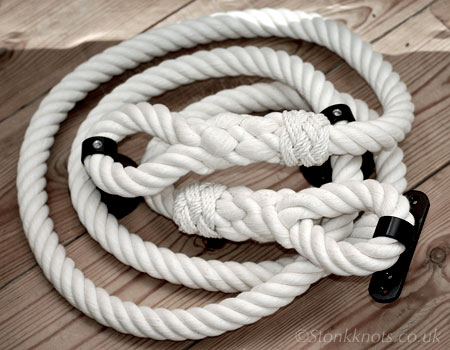
- Can you send samples?
- How do I contact you?
- What are your lead times?
- How many fittings do I need?
- At what height should I set the rope?
- Do the fittings have to be in fixed positions on the rope?
- Should I allow for a drop between the brackets?
- Do I need to order extra rope for the knots?
- What is the difference between a 2 ply and a 3 ply Manrope knot?
- How do I measure for a rope which turns a corner?
- Can your rope rails replace a solid handrail in terms of strength?
- Do building regulations affect the installation of a rope bannister?
- Which ropes would you recommend for outdoor use?
- Can we use your rope handrail fittings outside?
- I want to replace an existing stair rope, but the brackets look O.K.
- Can I order from overseas?
- How do I clean my stair rope?
- Is your website safe to browse?
- Do you produce a separate brochure?
Can you send samples?
Yes - we can send a sample pack of short lengths of rope free of charge to a U.K. address, for you to check the colour, texture, size and construction of the rope. For rope samples to overseas destinations, please enquire for carriage costs. We can also send bracket samples as a paid service with the fitting price refunded on return to us.
Back
How do I contact you?

Hemp rope with brushed steel fittings installed
Wasing Park Estate, UK image: StairRopes.com
The quickest way to contact us is by email. You can find all our contact details on the contact page.
We normally respond to enquiries on the same day, although at busy times replies may take up to 48 hours. Let us know your requirements and any other questions you might have. More information on our order page.
We are happy to consult by telephone. If you would like us to call you, please email first with your number. You can also contact us by writing to us or through a pre-arranged visit by appointment.
Back
What are your lead times?

This will very much depend on the choice of materials and our current workload; We have an auto-reply in place which confirms receipt of email enquiries and also details the current response and lead times.
Bannister ropes and handrails are made to individual specification and our usual delivery schedule starts at two weeks from ordering. Some bespoke orders which include a custom design, finish or shape the lead time may run to several weeks ahead.
If you have an urgent or specific enquiry, please drop us a quick email with your details to check on the latest delivery slots and stock situation. We will estimate the delivery time when you order, and email you when your parcel is despatched. If you have a specific deadline to meet, let us know and we will do our best!
Back
How many fittings do I need?
One every metre is a good guide, although the right number will depend on how you want the rope to look and how important it is for the rope to give support. Also, where space is tight, for example on a spiral staircase, there could be a bracket every half metre.
Although both the brackets and the rope are very strong, the more brackets there are, the more secure the bannister rope will feel.
Back
At what height should I set the rope?
One metre is a fairly standard height for a rope bannister, but consider what is comfortable for you and how it will look on your staircase. See also Q. below - Do building regulations affect the installation of a bannister rope?
Back
Do the fittings have to be in fixed positions on the rope?
Fittings need to be set on a rope handrail by their retaining screws (locking pins) - this prevents the rope from slipping and chafing in the bracket.
The end brackets will be fixed as determined by the length of the rope, so it is important to make sure of this measurement; however, the centre brackets may be left loose on the rope - for example if you are not sure exactly where these will go until the bannister rope is in place. In this case, the retaining screws will be supplied separately to be fitted on site - the job is a little tricky but we can provide instructions.
Back
Should I allow for a drop between the brackets?

If you measure straight between each bracket position, the weight of the rope will give a natural curve. If you want a deeper drop, use a piece of string to make sure you get the right look, but bear in mind that there will be more give in the rope bannister when it is used for support.
Back
Do I need to order extra rope for the knots?
No - the rope used to make the knot is included in the price of the knot.
Back
What is the difference between a 2 ply and a 3 ply Manrope knot?
This denotes how many times the pattern of the knot is followed around. The 3 ply is a larger, more complex knot, taking longer to tie and tighten. Both 2 ply and 3 ply knots are equally secure as end knots; the choice is yours - a 24mm rope 2 ply knot is about the size of a tennis ball, a 3 ply is equivalent to a small grapefruit. In the larger diameter rope, a 2 ply knot is comparable to a 3 ply knot in 24mm rope, the 3 ply knot is very impressive! - see the Knots page for more information and pictures of the different knots.
Back

2-ply & 3ply Manrope Knots in 24 & 32mm Hemp
How do I measure for a rope which turns a corner?
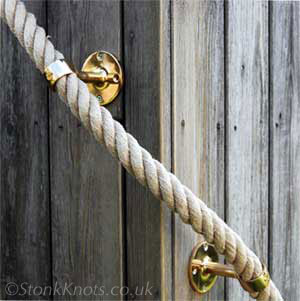
See our section on corners which explains in detail how to calculate the rope length needed for a corner.
Alternatively, you can forward us details, a plan diagram or an image of your particular situation, and we can work out the measurement required.
Back
Can your rope rails replace a solid handrail in terms of strength?
Yes, our rope rails are intended as fully functional handrails, not just as a decorative guide.
With rope breaking strains exceeding four tons and brackets specified for the purpose, the weakest point in the installation is more likely to be the fixing surface itself!
Do building regulations affect the installation of a rope bannister?
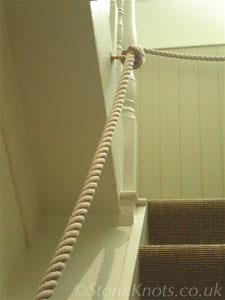
Building regulations specify that a handrail should be between 900 mm and 1000 mm in height. The other aspects of the regulations affecting a bannister rope installation will depend on the particular application, how securely the rope has been attached to the wall and also on the individual inspector.
Our rope bannisters are functional hand rails, properly made with knots or splices at each end and strong fittings with four points of attachment to the wall and secured to the rope by retaining screws (locking pins).
We have supplied many stair ropes which have been approved by UK building inspectors - generally, they are pleased to see a proper job rather than a last minute lash up! Some feedback on this from one of our customers.
Back
Which ropes would you recommend for outdoor use?

An untreated natural fibre rope will last only a couple of years if used outside, depending on the circumstances; the rope will absorb the moisture and then shrink, trapping the moisture and rotting from within. Ropes such as hemp or manila are a little better than most because they retain some of the plant's natural oil, so if you have a well ventilated situation you could use these, but both will eventually bleach or discolour in the sunlight, plus there is the shrinkage to consider, so you will have to allow a little more drop in the rope to account for this.
Although all synthetic ropes are generally water-proof, many of them become brittle in sunlight - polypropylene being one of the worst culprits; the small fibres of the yarn will tend to whiten, becoming rough and almost sharp at first, finally rubbing off completely as a powder.
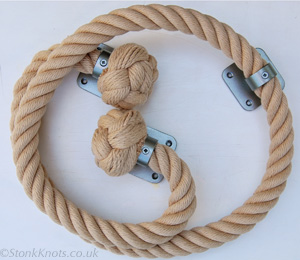
The rope itself is still serviceable for a good long time, but it will look and feel scruffy long before a polyester rope. Many imitation hemp ropes are made from polypropylene as it is quite a cheap raw material.
The rope we would recommend is the P.O.S.H., a high grade polyester fibre rope developed as a quality working rope for classic yachts with a built-in U.V. inhibitor - so it will keep its good looks outside for much longer! We have it made especially in a four strand construction which produces an attractive and comfortable handrail, as it is less bumpy than the usual three strand rope. We supply p.o.s.h. in a natural colour (hemp imitation). See our POSH rope section for more information.
Back
Can we use your rope handrail fittings outside?

For exterior applications, we offer rope handrail brackets in stainless steel, wrought iron or brass.
Our satin and mirror finish stainless steel fittings are made from marine grade 316 stainless steel and have the best resistance to corrosion and staining of all the materials. We supply stainless steel screws for wall/post fixing; if you need to source longer/shorter screws, these should be stainless steel - not zinc plated steel, to guard against bi-metallic reaction.
Wrought iron brackets are made of mild steel, a very durable material often used for gates and railings etc. When exposed to moisture, it corrodes by oxidising in the form of rust so is usually protected by a metal paint. We supply a variety of hard wearing paint finishes on our wrought iron hand rail fixtures and for outdoor applications a zinc rich primer is applied.
Bear in mind that the rustic finishes we offer on our wrought iron stair rope brackets (hammered and brushed steel) are protected only by a lacquer which has minimal UV resistance, so these are not really weatherproof.
Brass is an alloy that is commonly used in marine environments because it does not corrode in the same way as steel; it is protected either by polishing or by a lacquer. The problem with lacquers is that they deteriorate over the years and this process is uneven and can look unattractive. Our brass brackets are polished but unlacquered so unless they are regularly polished, they will patinate (dull) naturally as they age.
Back
I want to replace an existing stair rope, but the brackets look O.K.
You can send the brackets to be fitted on a new bannister rope. Contact us first to discuss - e.g. to confirm the bracket diameter etc.
Back
Can I order from overseas?
Yes! Our stair ropes have been shipped all over the world. Please contact us for a quote.
Back
How do I clean my stair rope?

Whilst the hemp, coloured ropes and natural p.o.s.h. tend not to show the marks, a cotton rope might need extra care.
If you can avoid soiling the rope first, or the rope is newly cleaned, then you might consider Scotchguard as a protective layer. We have had some positive feedback from customers on this, but there is a catch - when it wears off and needs another application, it is difficult to remove the first coat because it rubs into "bobbles".
Having researched this a while back by testing several upholstery cleaning products, we found that they tended to discolour the rope and were usually expensive. One tip is to use a sea sponge to clean the fibres as this generates less heat in use, and it is this heat that can make stains worse.
The simplest and most effective solution we found is to use a plain soap and work in gently with a soft toothbrush (or a sea sponge), taking care not to get the rope too wet or the fibres will tend to shrink, tighten and then trap the moisture; make it only just damp enough to get a lather. Leave for a couple of hours and then wipe off with a slightly damp cloth.
Back
Is your website safe to browse?
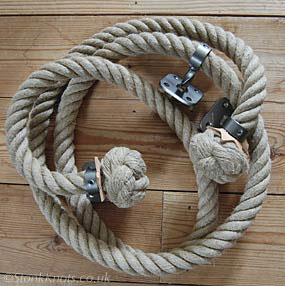
Both of our websites - Stairropes.com and Stonk Knots use the latest security protocols (https) which ensure all data transfer is securely encrypted. We have a very simple and safe interface which cannot collect, process or store personal data.
We have no mechanism set up to track your browsing or store information on your computer; Our website does not use cookies at all, nor do we link to or allow third parties to install cookies to collect user data anonymously for website analytics, advertising or social media. Please see our Privacy Policy for further details.
Our aim is to present an attractive and informative website in an easily accessible and logical format to assist you in making your choices (and, if we are fortunate, a purchase of a rope handrail from us!) without the use of overly complicated and often intrusive technology, advertisements and other distractions. We hope it proves to be a restful browsing experience.
Back
Do you produce a separate brochure?
Our shop window is StairRopes.com, so we do not produce a separate brochure. The website is very comprehensive and is the main point of reference; we update regularly and all details of prices and choices are accessible.
Back
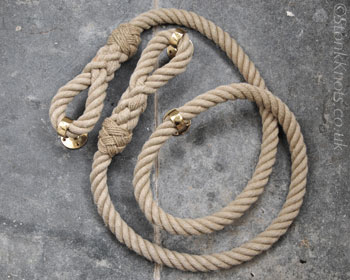
Hemp stair rope with eye splices and brass fittings
Contact Stair Ropes.com
For more advice or information about our bannister ropes and hand rails, you can contact James Watson directly. Full details on our contact page.
All content on this website is © (copyright) 1994-2025 - StairRopes.com and Stonk Knots, unless otherwise stated.
Web site design and photography by